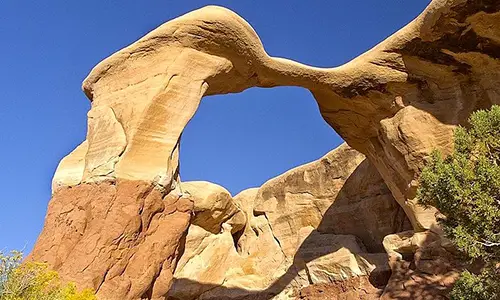The state of Utah, situated in eastern USA is well known for the Mountain Men who established trading posts in 1824 and the pioneers who between 1845 and 1847, travelled hundreds of miles to find a Mormon Homeland. All these activities were concentrated in the northern regions of the state. The more rugged remote southern regions of the state were settled much later.
The name Escalante is common in the region. A River, National Park, various monuments and a town all bear the name of the first European to visit the area.
Silvestre Velez de Escalante was a Franciscan monk. He was born in Spain. He was a missionary and spent many years in New Mexico looking after the Christian Indians at Zuni. He visited the Hopi villages and reported the ‘infidels who danced naked’. Escalante was also an explorer. Along with his superior Francisco Dominguez, he set out in 1776 to find an alternate route from Santa Fe to Monterey, California. The existing route was populated with cannibalistic Indians. They did not find what they were looking for but discovered the beauty of southern Utah and highly recommended it for colonization.
The Town of Escalante is tiny, but replete with adventurous hikes and trails. It was first settled in 1875. The population is about 785. The town lies in Garfield County Utah. In the 1860’s , during the Black Hawk Indian War, the South Utah troops passed through the valley and finding it full of wild potatoes , named it the Potato Valley. A group of settlers arrived at the valley in the 1870’s. The Powell expedition that was passing through the area recommended that the settlement be named after the first Spanish explorer in the region – Escalante. Dominguez was left out.
The Grand Staircase Escalante National Monument is a series of 5 spectacular natural steps rising up to 1675 meters. The colour of the cliffs of each step is different as is the natural vegetation that ranges from desert to evergreen forest. The ‘stair case ‘is situated in remote inaccessible country and is visited only by serious hikers.
The Escalante River is a tributary of the Colorado River. It is formed by the confluence of the Upper Valley and Birch Creeks, near Escalante Town. It flows through canyons of breath-taking beauty and joins Lake Powell, about 80 miles from its source. The River was first mapped in 1872, by Almon Thompson, a member of Powell’s expedition. The Escalante, a tiny little stream that can be stepped over, changes completely with the spring run-off and the summer monsoon. During these months the Escalante becomes a gushing, muddy torrent.
The Escalante Canyons are a series of beautiful arches, natural bridges and waterfalls amid towering cliff walls. These stunning land forms are created by the River Escalante and its tributaries as they rush through the sandstone beds in the spring and summer. This remote beautiful country is popular adventure tourist destination. The surrounding desert supports an unexpected variety of flora and fauna, including wildflowers, jackrabbits, coyotes and an occasional big horn sheep, rattlesnake or scorpion. The authorities are making every effort to preserve this fragile eco system and strict camping rules are in place.
Escalante Pueblo was a compact rectangular village overlooking the Dolores Village. It has been occupied over the years by different native tribes. The Ancient Pueblo people originally built it in CE 1129. The Pueblo consists of 28 rooms surrounding a central rounded room called the kiva. It now stands at the centre of the Anasazi Heritage Centre.
The Escalante Petrified Forest State Park is a Utah State Park. The Park has a vast display of plant and marine fossils and petrified wood. An added attraction I the collection of dinosaur bones from the Cretaceous Period (100 million years ago).











March 24, 2017 5:53 pm
Utah isn’t in the Eastern USA. Not even a little bit. Not even close. Get a map. Please.